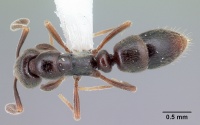Hypoponera sulcatinasis
| Hypoponera sulcatinasis | |
|---|---|

| |
| Scientific classification | |
| Kingdom: | Animalia |
| Phylum: | Arthropoda |
| Class: | Insecta |
| Order: | Hymenoptera |
| Family: | Formicidae |
| Subfamily: | Ponerinae |
| Tribe: | Ponerini |
| Genus: | Hypoponera |
| Species: | H. sulcatinasis |
| Binomial name | |
| Hypoponera sulcatinasis (Santschi, 1914) | |
| Synonyms | |
| |
Known from only a few specimens, nothing is known about the biology of Hypoponera sulcatinasis.
Identification
This large, darkly coloured species is immediately recognisable by its densely sculptured propodeal dorsum, which is easily the most strongly sculptured in the boerorum group. In the region as a whole the propodeal sculpture of sulcatinasis is approached only by Hypoponera hebes, but that species belongs to the abeillei group.
Keys including this Species
Distribution
Latitudinal Distribution Pattern
Latitudinal Range: -29.331105° to -29.76667°.
| North Temperate |
North Subtropical |
Tropical | South Subtropical |
South Temperate |
- Source: AntMaps
Distribution based on Regional Taxon Lists
Afrotropical Region: South Africa (type locality).
Distribution based on AntMaps
Distribution based on AntWeb specimens
Check data from AntWeb
Countries Occupied
| Number of countries occupied by this species based on AntWiki Regional Taxon Lists. In general, fewer countries occupied indicates a narrower range, while more countries indicates a more widespread species. |

|
Estimated Abundance
| Relative abundance based on number of AntMaps records per species (this species within the purple bar). Fewer records (to the left) indicates a less abundant/encountered species while more records (to the right) indicates more abundant/encountered species. |

|
Biology
Castes
Nomenclature
The following information is derived from Barry Bolton's Online Catalogue of the Ants of the World.
- sulcatinasis. Ponera sulcatinasis Santschi, 1914e: 4 (w.) SOUTH AFRICA. Combination in Hypoponera: Bolton, 1995b: 216. Senior synonym of devota: Bolton & Fisher, 2011: 103.
- devota. Ponera spei st. devota Santschi, 1914e: 5 (w.) SOUTH AFRICA. Combination in Hypoponera: Bolton, 1995b: 214. Junior synonym of sulcatinasis: Bolton & Fisher, 2011: 103.
Unless otherwise noted the text for the remainder of this section is reported from the publication that includes the original description.
Description
Worker
Bolton and Fisher (2011) - Measurements: HL 0.78–0.82, HW 0.65–0.70, HS 0.715–0.760, SL 0.60–0.65, PrW 0.48–0.54, WL 1.08–1.20, HFL 0.61–0.66, PeNL 0.22–0.24, PeH 0.50–0.56, PeNW 0.36–0.41, PeS 0.360–0.400 (15 measured). Indices: CI 82–85, SI 88–96, PeNI 72–79, LPeI 42–44, DPeI 164–178.
Eyes present, small but distinct, of about 4–6 ommatidia. In full-face view apex of scape, when laid straight back from its insertion, touches or slightly exceeds the midpoint of the posterior margin; SL/HL 0.75–0.80. Reticulate-punctulate sculpture of cephalic dorsum strong and conspicuous. Pronotal dorsum punctate, less densely so than head, the individual punctures distinct and more widely spaced. Lower half of side of pronotum much less densely sculptured than dorsum. Propodeal dorsum reticulate-punctate, the sculpture covering the entire surface; the sculptured dorsum contrasts strongly with the smooth, shining declivity. Mesonotal-mesopleural suture absent to vestigially present, and sometimes with a weak remnant of a transverse suture on the mesopleuron. Metanotal groove distinctly incised on dorsum of mesosoma; mesonotum with a well-defined posterior margin. Propodeal declivity separated from side by an angle or a weak margination, without sharp carinae. Mesopleuron mostly unsculptured but there may be weak sculpture peripherally. Petiole in profile with the anterior and posterior faces of the node usually very weakly convex and weakly convergent dorsally; node distinctly longer just above the anterior tubercle than at the dorsum. Subpetiolar process a lobe with a sharp or blunt ventral angle. Anterior margin of subpetiolar process, near its base, with a conspicuous pit from which a sensory seta arises. Maximum width of first gastral tergite in dorsal view subequal to or slightly greater than the width of the second tergite at its midlength. Base of cinctus of second gastral tergite with strong cross-ribs. Posttergite of second gastral segment, from posterior margin of cinctus to apex, distinctly broader than long. Disc of second gastral tergite reticulate-punctate to microreticulate, the sculpture strong and conspicuous. With first gastral segment in profile its dorsum usually without standing setae except at the apex of the tergite; occasionally one or two very short, inconspicuous setae may be present. Full adult colour dark brown, blackish brown, or mostly black; sometimes with reddish areas.
Type Material
Bolton and Fisher (2011):
Syntype workers and queen, SOUTH AFRICA: Natal, Richmond (I. Trågärdh) (Naturhistorisches Museum, Basel) [examined].
Ponera spei st. devota Syntype worker (teneral), SOUTH AFRICA: Natal, Richmond (I. Trågärdh) (NHMB) [examined].
References
- Bolton, B. 1995b. A new general catalogue of the ants of the world. Cambridge, Mass.: Harvard University Press, 504 pp. (page 216, Combination in Hypoponera)
- Bolton, B., Fisher, B.L. 2011. Taxonomy of Afrotropical and West Palaearctic ants of the ponerine genus Hypoponera Santschi. Zootaxa 2843: 1-118.
- Santschi, F. 1914e. Meddelanden från Göteborgs Musei Zoologiska Afdelning. 3. Fourmis du Natal et du Zoulouland récoltées par le Dr. I. Trägårdh. Göteb. K. Vetensk. Vitterh. Samh. Handl. 15: 1-44 (page 4, worker described)
References based on Global Ant Biodiversity Informatics
- Arnold G. 1926. A monograph of the Formicidae of South Africa. Appendix. Annals of the South African Museum. 23: 191-295.
- Bolton B. and B. L. Fisher. 2011. Taxonomy of Afrotropical and West Palaearctic ants of the ponerine genus Hypoponera Santschi (Hymenoptera: Formicidae). Zootaxa 2843: 1-118
- Bolton, B., and B. L. Fisher. "Taxonomy of Afrotropical and West Palaearctic ants of the ponerine genus Hypoponera Santschi (Hymenoptera: Formicidae)." Zootaxa 2843 (2012): 1-118.
- Santschi F. 1914. Meddelanden från Göteborgs Musei Zoologiska Afdelning. 3. Fourmis du Natal et du Zoulouland récoltées par le Dr. I. Trägårdh. Göteborgs Kungliga Vetenskaps och Vitterhets Samhälles Handlingar. 15: 1-44.
- Wheeler W. M. 1922. Ants of the American Museum Congo expedition. A contribution to the myrmecology of Africa. VIII. A synonymic list of the ants of the Ethiopian region. Bulletin of the American Museum of Natural History 45: 711-1004

